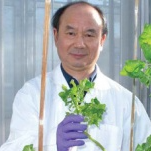Potato Genetics and Breeding in the Genomics Era
A special issue of Agronomy (ISSN 2073-4395). This special issue belongs to the section "Crop Breeding and Genetics".
Deadline for manuscript submissions: closed (31 July 2019) | Viewed by 17369
Special Issue Editors
Interests: plant virology; plant viruses and viroids; plant-virus interactions; potato diseases and management
Interests: genetics; breeding; genomics; potato; marker-assisted selection; crop bioinformatics; breeding values; population improvement
Special Issues, Collections and Topics in MDPI journals
Special Issue Information
Dear Colleagues,
Potato is—and has long been—one of the major food crops grown worldwide and, with the human population increasing, it will no doubt continue to help feed the masses. In present day, the majority of potato cultivars are tetraploid and propagated vegetatively, with the breeding strategy being primarily based on phenotypic selection. As such, eliminating deleterious alleles and improving crops has proven laborious and difficult. Furthermore, over the years, potato has been no stranger to disease agents of all kinds, and the continual appearance of potato pests will not likely soon cease. As we stand, in the genomics era, breakthroughs and technologies that have come about in the last quarter-century provide us brand-new approaches to studying potato genetics and breeding, and the time has never been better to work on this important crop species. In this Special Issue, we welcome original research, reviews and opinions concerning recent insights, approaches, and advances in potato genetics and the optimization of potato breeding; we hope this will serve as a cache of up-to-date knowledge for researchers, farmers, and industry.
Dr. Xianzhou Nie
Dr. David De Koeyer
Guest Editors
Manuscript Submission Information
Manuscripts should be submitted online at www.mdpi.com by registering and logging in to this website. Once you are registered, click here to go to the submission form. Manuscripts can be submitted until the deadline. All submissions that pass pre-check are peer-reviewed. Accepted papers will be published continuously in the journal (as soon as accepted) and will be listed together on the special issue website. Research articles, review articles as well as short communications are invited. For planned papers, a title and short abstract (about 100 words) can be sent to the Editorial Office for announcement on this website.
Submitted manuscripts should not have been published previously, nor be under consideration for publication elsewhere (except conference proceedings papers). All manuscripts are thoroughly refereed through a single-blind peer-review process. A guide for authors and other relevant information for submission of manuscripts is available on the Instructions for Authors page. Agronomy is an international peer-reviewed open access monthly journal published by MDPI.
Please visit the Instructions for Authors page before submitting a manuscript. The Article Processing Charge (APC) for publication in this open access journal is 2600 CHF (Swiss Francs). Submitted papers should be well formatted and use good English. Authors may use MDPI's English editing service prior to publication or during author revisions.
Keywords
- Potato
- Genetics
- Breeding
- Genomics






